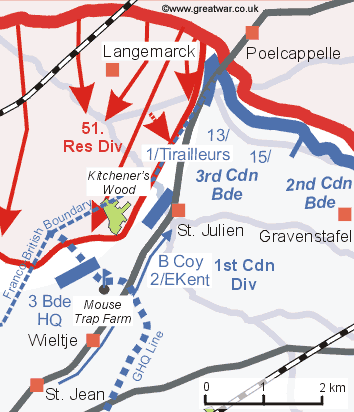 The Canadian line holds firm
The Canadian line holds firm
22 April 1915: 21.00
Just before 9pm units of the German 51. Reserve Division attacked the French 1st Company of the 1st Tirailleurs on the left of the Canadians at the St. Julien-Poelcappelle road. The French gave way but about 200 Frenchmen did join the six Canadian platoons of the 13th Battalion (i.e. four from No. 1 Company and two supporting platoons from No. 3 Company) now holding the position of a new flank following the line of the St. Julien-Poelcappelle road.

A report from Captain G E McCuaig, adjutant of 13th Battalion, confirmed that all the lines were holding in his sector. His message went on:
“Reported that all our wire entanglements are down aaa Will need ammunition and rations here also badly need our motorcycles aaa Bombardment still continues but not so heavy.” (1)
The 15th Canadian Battalion also reported from their front line position at 9pm that there had been heavy enemy shelling at about that time and that some French had retired on their left:
“Everything O.K. all trenches and Adv. H.Q. [Advanced Headquarters] heavily shelled, no casualties, a number of French retired on our left probably 50... I need more ammunition...” (2)
2nd Battalion East Kent Regiment (the Buffs) Moves to Support the 3rd Canadian Brigade at St. Julien
Brigadier-General Turner received a message at his 3rd Brigade headquarters in Mouse Trap Farm at 9pm. It was from 1st Canadian Division headquarters (Chateau des Trois Tours, Brielen) confirming to him that a battalion of the 28th Division, 2nd Battalion the East Kent Regiment (the Buffs), was on its way to support him. Colonel A D Geddes (2) was the commanding officer of this battalion. The battalion was from the 28th Division reserve and had moved to a position north of St. Jean shortly after the German attack had been launched.
In the event, Colonel Geddes sent a message a couple of hours later to confirm that he was sending only one company (B Company under command of Captain F W Tomlinson) to St. Julien in support of 13th Battalion there:
“Am sending one company Buffs [2/E. Kent] to report to Senior Officer Canadians ST. JULIEN aaa O.C. [Officer Commanding] Buffs will send officer and orderlies to report Bde. Head Qrs. [Brigade Headquarters] as requested.” (3)
When it arrived at St. Julien this company was to hold the line from St. Julien to Mouse Trap Farm acting under orders from Brigadier-General Turner at 3rd Brigade headquarters.(4)
Next>> 3rd Brigade Canadian Field Artillery batteries withdraw
Acknowledgements & Notes
(1) Official History of the Canadian Forces in The Great War 1914-1919, Appendices, no. 373, p. 243
(2) Colonel Augustus David Geddes was to be killed seven days later on 28 April 1915, aged 48. He was the son of Col. John Geddes, of 4, Suffolk Square, Cheltenham; husband of Vera Colville Goff (formerly Geddes), of 16, Lincoln House, Basil St., Chelsea, London. He is buried in Ypres Resevoir Cemetery, Grave Reference: IV. C. 4. See the page
(3) Official History of the Canadian Forces in The Great War 1914-1919, Appendices, no. 378, p. 244
(4) Official History of the Canadian Forces in The Great War 1914-1919, Appendices, no. 391, p. 246